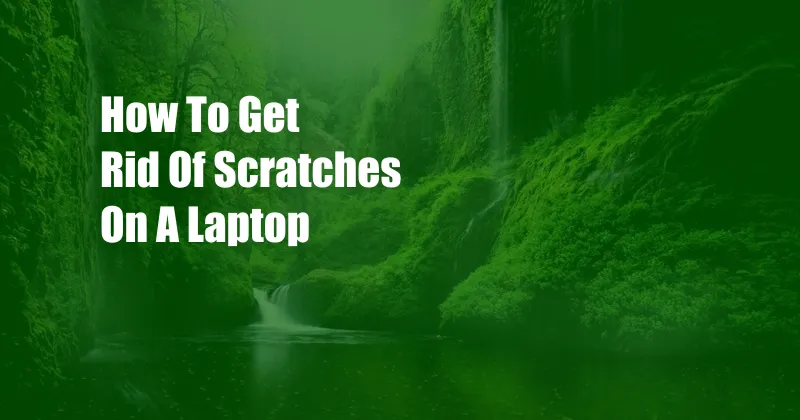
How to Get Rid of Scratches on a Laptop: A Comprehensive Guide
Have you ever been frustrated by a scratch on your laptop screen or case? Scratches not only affect the aesthetics of your device but can also impair visibility and compromise its functionality. Whether it’s a minor scuff or a deep gouge, there are effective methods to remove or minimize the appearance of scratches on your laptop.
In this comprehensive guide, we will explore a range of techniques to get rid of scratches on your laptop. We’ll provide step-by-step instructions, delve into the latest trends and developments, share tips and expert advice, and address common FAQs to empower you with the knowledge and skills to restore the pristine condition of your laptop.
Understanding Laptop Scratches
Scratches on laptops can occur due to various reasons, including accidental contact with sharp objects, abrasive surfaces, or improper cleaning methods. The severity of the scratch depends on the depth and type of material affected. Superficial scratches typically affect the clear plastic outer layer, known as the screen protector or case coating, while deeper scratches may penetrate the actual display panel or case material.
Identifying the type and depth of the scratch is crucial in determining the most appropriate removal method. Superficial scratches can often be buffed out or removed using common household items, while deeper scratches may require professional repair or replacement.
Step-by-Step Scratch Removal Techniques
For superficial scratches on the screen protector or case coating:
- Toothpaste: Apply a small amount of white, non-gel toothpaste to a soft, damp cloth and gently rub in circular motions. Toothpaste contains mild abrasives that can gently remove scratches without damaging the surface.
- Baking Soda: Mix baking soda with a small amount of water to form a paste. Apply the paste to the scratched area and let it sit for about 15 minutes. Wipe away the paste with a damp cloth and dry thoroughly.
- Commercial Scratch Remover: Consider using a commercial scratch remover specifically designed for laptops. Follow the instructions carefully and apply the remover to the scratched area with a soft cloth.
For deeper scratches on the display panel or case material:
- Professional Repair: If the scratch is deep and affects the actual display panel or case material, it’s advisable to seek professional repair. A trained technician can assess the damage and recommend the best course of action, which may involve screen or case replacement.
- Scratch Concealers: For minor scratches that do not affect the functionality of the laptop, you can use scratch concealers specifically designed for laptops. These concealers fill in the scratches, making them less visible.
Latest Trends and Developments in Scratch Removal
The field of scratch removal is constantly evolving, with new products and techniques emerging to meet the needs of laptop users. Here are some of the latest trends and developments:
- Nanotechnology: Nanotechnology-based products utilize extremely small particles to fill in scratches and create a smooth surface. These products offer long-lasting results and can be used on both screen protectors and display panels.
- Laser Scratch Removal: Laser scratch removal is a professional technique that uses a high-powered laser to vaporize the damaged material, effectively removing the scratch. This method is highly precise and can remove even deep scratches.
Tips and Expert Advice for Scratch Prevention
Preventing scratches on your laptop is crucial to maintain its pristine condition. Here are some tips and expert advice to help you protect your device:
- Use a Laptop Sleeve: Always store and transport your laptop in a protective sleeve or case to prevent scratches from external objects.
- Clean Regularly: Clean your laptop screen and case regularly using a soft, damp cloth and an appropriate cleaning solution. Avoid using abrasive cleaners or cloths that can cause scratches.
- Be Careful with Accessories: Pay attention when using external accessories, such as USB drives or headphones, to ensure they don’t scratch the laptop’s surface.
- Use a Screen Protector: Applying a screen protector can provide an additional layer of protection against scratches and damage.
By following these tips, you can significantly reduce the risk of scratches on your laptop and extend its lifespan.
Frequently Asked Questions about Laptop Scratches
Q: Can I use a polishing compound to remove scratches on my laptop?
A: No, polishing compounds are typically abrasive and can further damage the surface of your laptop. Stick to the methods outlined above that are specifically designed for laptop scratch removal.
Q: Is it possible to remove deep scratches from my laptop screen?
A: While superficial scratches can be removed using home remedies or commercial scratch removers, deep scratches that affect the display panel may require professional repair or replacement.
Conclusion
Laptops are essential devices that play a crucial role in our daily lives. Maintaining their pristine condition enhances not only their appearance but also their functionality. By understanding the different types of scratches, utilizing the appropriate removal techniques, and following preventive measures, you can effectively get rid of scratches on your laptop and ensure its longevity. If you have any further questions or concerns, don’t hesitate to seek assistance from laptop repair professionals.
Would you like to learn more about laptop scratch removal techniques? Share your thoughts and experiences in the comments below.